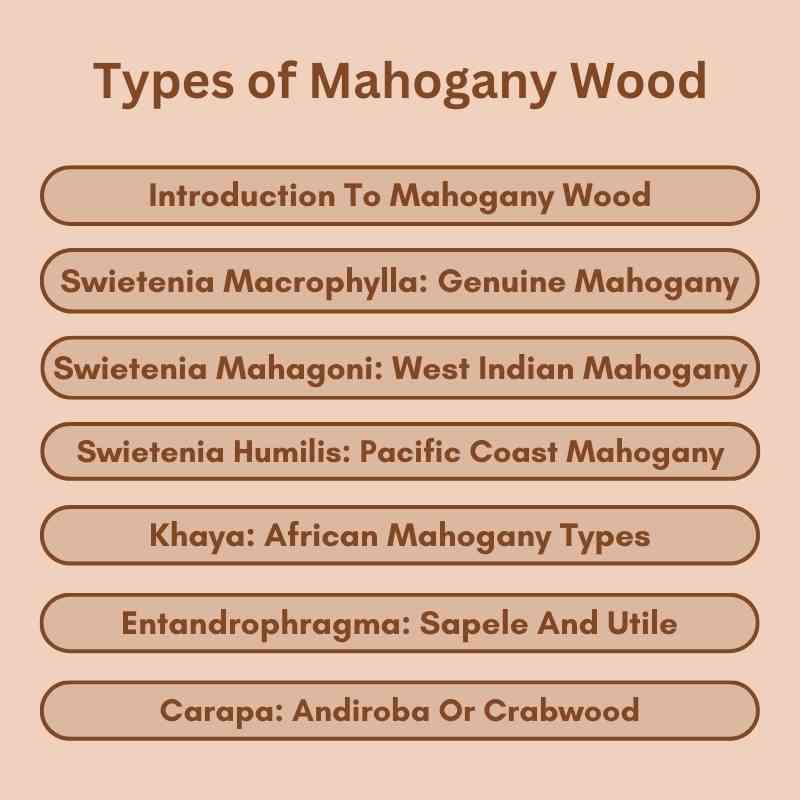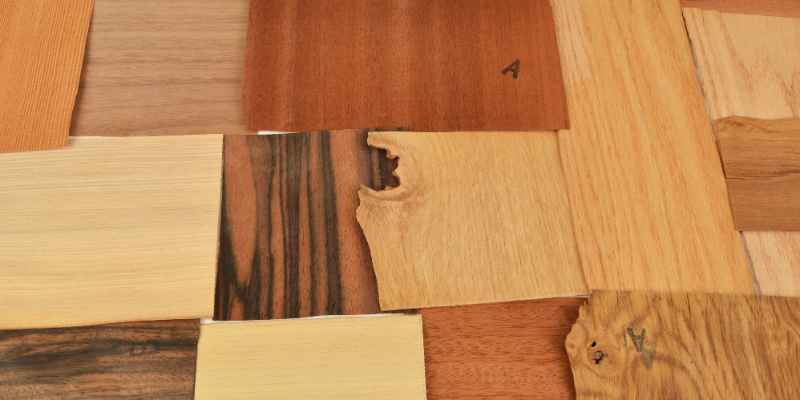Mahogany wood primarily comes from three main types: Swietenia macrophylla, Swietenia mahagoni, and Khaya ivorensis. Each type offers unique characteristics, making them suitable for various applications.
Mahogany is a highly sought-after hardwood known for its durability and rich color. It has a long-standing reputation in furniture making and cabinetry. The wood is prized for its fine grain and resistance to decay, making it an excellent choice for both indoor and outdoor use.
Different types of mahogany vary in color, grain, and availability, influencing their applications. Swietenia macrophylla, often referred to as Honduran mahogany, is the most popular. Khaya ivorensis, or African mahogany, offers an alternative with similar qualities. Choosing the right type of mahogany depends on your project’s specific needs and aesthetic preferences.
Introduction To Mahogany Wood
Mahogany wood is renowned for its beauty and durability. This rich, reddish-brown hardwood is popular in furniture and cabinetry. Its unique features make it a favorite among craftsmen and builders.
Origin And Historical Significance
Mahogany has a rich history and diverse origins. Here are some key points:
- Native Regions: Mahogany primarily comes from Central and South America.
- Historical Use: Used by ancient civilizations for building and crafting.
- Trade Value: Highly valued in the 18th and 19th centuries.
This wood has shaped furniture styles and trends. Its luxurious appearance attracts many buyers. Mahogany symbolizes wealth and craftsmanship.
Characteristics And Uses
Mahogany wood has distinct characteristics that enhance its appeal.
| Characteristic | Description |
|---|---|
| Color: | Rich reddish-brown that deepens over time. |
| Grain: | Straight and fine, often with a beautiful sheen. |
| Durability: | Resistant to moisture and pests. |
| Workability: | Easily cut, shaped, and polished. |
Common uses of mahogany include:
- Furniture such as tables and chairs.
- Cabinetry and cabinetry accents.
- Musical instruments like pianos and guitars.
- Boat building due to its resistance to water.
Mahogany is a top choice for artisans and builders. Its timeless appeal enhances any space.

Swietenia Macrophylla: Genuine Mahogany
Swietenia Macrophylla, commonly known as Genuine Mahogany, is a prized hardwood. It is renowned for its beauty and durability. This wood comes from tropical forests. Its deep reddish-brown color makes it a favorite in woodworking.
Habitat And Distribution
Genuine Mahogany grows in various regions. It primarily thrives in Central and South America. Here are some key facts:
- Found in countries like:
- Honduras
- Belize
- Brazil
- Colombia
- Prefers tropical rainforests with high humidity.
- Can reach heights of up to 150 feet.
Physical Properties
Genuine Mahogany possesses unique physical properties. These features make it suitable for various applications. Here’s a breakdown:
| Property | Description |
|---|---|
| Color | Rich reddish-brown that darkens with age. |
| Grain | Straight, with occasional wavy patterns. |
| Density | Medium density, weighing about 30-35 lbs per cubic foot. |
| Workability | Easy to work with, sands well, and takes finishes beautifully. |
Applications In Woodworking
Genuine Mahogany is versatile in woodworking. It is commonly used for:
- Furniture: Chairs, tables, and cabinets.
- Musical Instruments: Guitars and pianos.
- Boat Building: Excellent for marine applications.
- Interior Trim: Molding and paneling in homes.
This wood’s beauty and longevity enhance any project. It remains a top choice among woodworkers.
Swietenia Mahagoni: West Indian Mahogany
Swietenia Mahagoni, commonly known as West Indian Mahogany, is a highly prized hardwood. This tree species thrives in the Caribbean and Central America. Its rich color and durability make it popular in furniture and boat building.
Unique Features
West Indian Mahogany has several unique characteristics:
- Color: Ranges from golden brown to reddish-brown.
- Grain: Features a straight grain with occasional interlocking.
- Durability: Highly resistant to decay and insect damage.
- Workability: Easy to work with hand and machine tools.
This wood also has a natural luster that enhances its beauty. It often ages gracefully, developing a richer hue over time.
Conservation Status
Swietenia Mahagoni faces significant threats:
| Threats | Status |
|---|---|
| Deforestation | Critical |
| Illegal Logging | Prevalent |
| Habitat Loss | Severe |
This species is listed as endangered. Conservation efforts are crucial for its survival.
Common Uses
West Indian Mahogany is used in various applications:
- Furniture: Dining tables, chairs, and cabinets.
- Musical Instruments: Guitars and pianos.
- Boat Building: Hulls and decks of boats.
- Interior Woodwork: Paneling and moldings.
Its beauty and strength make it a favorite choice for artisans.
Swietenia Humilis: Pacific Coast Mahogany
Swietenia Humilis, commonly known as Pacific Coast Mahogany, is a prized wood species. It thrives in tropical regions of Central and South America. This type of mahogany is celebrated for its beauty and durability. Craftsmen value it for making fine furniture and decorative pieces.
Geographical Range
Pacific Coast Mahogany primarily grows along the Pacific coasts of:
- Mexico
- Central America
- Parts of South America
This species prefers humid, tropical climates. It flourishes in well-drained soils. Areas with consistent rainfall provide the ideal environment.
Timber Qualities
Swietenia Humilis has unique characteristics that enhance its appeal:
| Quality | Description |
|---|---|
| Color | Rich reddish-brown hues |
| Grain | Straight and fine grain |
| Durability | Highly resistant to decay |
| Workability | Easily shaped and finished |
This wood is often used in cabinetry, flooring, and musical instruments. Its natural luster makes it visually striking.
Cultural Importance
Swietenia Humilis holds significant cultural value in various communities:
- Traditional craftspeople use it for art and furniture.
- Many cultures celebrate it in local ceremonies.
- It supports local economies through sustainable harvesting.
Using this wood promotes cultural heritage. It connects people to their history and traditions.
Khaya: African Mahogany Types
Khaya wood is known as African mahogany. It offers beauty and durability. Different species of Khaya provide unique qualities. Here, we explore three main types of Khaya wood.
Khaya Ivorensis
Khaya Ivorensis is often called Ivorian mahogany. This species is native to West Africa. It features a rich, reddish-brown color.
- Grain: Straight and interlocked.
- Texture: Fine and even.
- Durability: Highly resistant to decay.
It is popular for furniture, cabinetry, and flooring.
Khaya Senegalensis
Khaya Senegalensis, known as Senegal mahogany, grows in West Africa. It has a lighter color than Ivorensis.
- Color: Light brown to pinkish-brown.
- Grain: Generally straight.
- Texture: Medium to coarse.
This type is commonly used in marine applications and boat building.
Khaya Anthotheca
Khaya Anthotheca is also referred to as African mahogany. It is found in Central and West Africa.
- Color: Reddish-brown with yellowish streaks.
- Grain: Interlocked and variable.
- Durability: Good resistance to wear.
This wood is ideal for cabinetry and decorative items.
Industry Preference
Different industries prefer various Khaya types. Here’s a quick comparison:
| Type | Common Uses | Key Features |
|---|---|---|
| Khaya Ivorensis | Furniture, cabinetry, flooring | Rich color, highly durable |
| Khaya Senegalensis | Marine applications, boat building | Light color, straight grain |
| Khaya Anthotheca | Cabinetry, decorative items | Reddish-brown, good wear resistance |
Choose the right Khaya type for your project. Each offers unique qualities for various applications.
Entandrophragma: Sapele And Utile
Entandrophragma is a genus of trees known for its valuable hardwoods. Two popular species are Sapele and Utile. These woods are prized for their beauty and durability. They are commonly used in furniture, cabinetry, and musical instruments. Understanding their characteristics helps in choosing the right wood for your project.
Entandrophragma Cylindricum
Entandrophragma Cylindricum, commonly known as Sapele, is native to tropical Africa. It features a rich, reddish-brown color. Sapele is often compared to mahogany due to its appearance.
- Color: Reddish-brown to golden-brown
- Grain: Interlocked, often with a shimmering effect
- Density: Medium to high, making it durable
Sapele works well for both indoor and outdoor projects. Its resistance to decay adds to its appeal. Sapele is often used for:
- Furniture
- Cabinetry
- Musical instruments
Entandrophragma Utile
Entandrophragma Utile, also known as Utile or African Mahogany, has a lighter color than Sapele. It is a popular choice for various applications.
- Color: Light to dark reddish-brown
- Grain: Straight, sometimes with a wavy pattern
- Density: Similar to Sapele, but slightly lighter
Utile is often used in high-quality furniture and cabinetry. It has good workability and finishes well. Common uses include:
- Boat building
- Interior millwork
- High-end furniture
Identifying Characteristics
| Characteristic | Sapele | Utile |
|---|---|---|
| Color | Reddish-brown | Light to dark reddish-brown |
| Grain | Interlocked | Straight, sometimes wavy |
| Density | Medium to high | Similar to Sapele |
Market Demand
The demand for both Sapele and Utile remains strong. Sapele is often favored for its beauty and durability. Utile is popular for its versatility in high-end projects.
- Sapele is sought after for furniture making.
- Utile is preferred for marine applications.
- Both species are sustainable choices when sourced responsibly.
Understanding these woods helps in making informed choices. Both Sapele and Utile offer unique qualities for various applications.
Carapa: Andiroba Or Crabwood
Carapa, commonly known as Andiroba or Crabwood, is a unique type of wood. It comes from the Carapa guianensis tree. This tree is native to the Amazon rainforest. Andiroba has a beautiful color and grain. It is often confused with true mahogany due to its appearance. Understanding its characteristics helps in choosing the right wood for your project.
Botanical Profile
The Andiroba tree has a scientific name of Carapa guianensis. It can grow up to 30 meters tall. The bark is gray-brown, and the leaves are compound. Here are some key details:
- Family: Meliaceae
- Height: Up to 30 meters
- Diameter: Up to 1 meter
- Color: Light to dark brown
- Grain: Interlocking and medium to coarse texture
Comparison With True Mahogany
True mahogany comes from the Swietenia genus. It is more expensive than Andiroba. Here’s a quick comparison:
| Feature | True Mahogany | Andiroba (Crabwood) |
|---|---|---|
| Color | Rich reddish-brown | Light to dark brown |
| Price | Higher | Lower |
| Durability | Very durable | Moderately durable |
| Workability | Easy to work with | Moderate workability |
Andiroba has a unique, attractive grain. It is suitable for furniture and cabinetry. True mahogany is often preferred for high-end projects.
Sustainability Concerns
Sustainability is crucial for wood selection. Andiroba is considered a more sustainable choice. Here are some points to consider:
- Andiroba trees regenerate quickly.
- Harvesting has minimal impact on forests.
- Supports local communities through sustainable practices.
True mahogany faces overharvesting issues. It is often sourced from endangered forests. Choosing Andiroba helps protect ecosystems.
Challenges In The Mahogany Trade
The mahogany trade faces many challenges. These issues threaten sustainability and legality. Understanding these challenges is vital for responsible sourcing.
Cites Regulations And Impact
The Convention on International Trade in Endangered Species (CITES) plays a crucial role. It aims to protect mahogany from over-exploitation.
CITES regulates the trade of mahogany. Countries must comply with specific guidelines to export or import.
- Mahogany is listed under CITES Appendix II.
- This listing requires permits for international trade.
- Non-compliance can lead to severe penalties.
These regulations help to:
- Protect mahogany forests.
- Ensure sustainable practices.
- Support local communities.
Illegal Logging Issues
Illegal logging poses a significant threat to mahogany. Unscrupulous practices lead to deforestation.
Effects of illegal logging include:
- Loss of biodiversity.
- Disruption of ecosystems.
- Economic losses for local communities.
Governments and organizations work to combat this issue. They promote awareness and enforce stricter laws.
Some key initiatives include:
| Initiative | Description |
|---|---|
| Certification Programs | Ensure wood comes from sustainable sources. |
| Monitoring Systems | Track logging activities in real-time. |
Sustainable Alternatives
Sustainable alternatives to mahogany exist. These options can reduce pressure on natural resources.
Some popular alternatives are:
- Sapele: A similar-looking wood with good durability.
- Khaya: Often used in furniture and flooring.
- Teak: Known for its water resistance and strength.
Choosing these alternatives supports sustainability. It promotes responsible forestry practices.
Selecting The Right Mahogany
Choosing the right mahogany involves understanding its unique features. Consider grain, color, strength, and cost. Each factor plays a role in your decision.
Grain And Color Considerations
Mahogany wood comes in various grains and colors. Different types offer unique aesthetics.
- Mahogany Grain: Ranges from straight to wavy.
- Color: Deep reddish-brown to light golden shades.
- Variations: Each piece may differ in hue and pattern.
Choose based on your project needs. Light-colored mahogany suits modern designs. Darker shades fit traditional styles.
Strength And Durability
Mahogany is known for its strength and longevity. It withstands wear and tear well.
| Type of Mahogany | Strength Rating | Durability |
|---|---|---|
| Honduran Mahogany | High | Excellent |
| Philippine Mahogany | Moderate | Good |
| Fijian Mahogany | High | Very Good |
Strong woods work best for furniture and cabinetry. Choose durable options for outdoor projects.
Price And Availability
Mahogany prices vary based on quality and type. Some types are more available than others.
- Honduran Mahogany: Generally more expensive.
- Philippine Mahogany: More affordable and widely available.
- Fijian Mahogany: Mid-range in price and availability.
Check local suppliers for stock. Always compare prices before buying.
Maintenance And Care
Proper care keeps mahogany wood looking beautiful. Regular maintenance prevents damage and enhances its natural charm. Follow these tips for cleaning, polishing, and preserving your mahogany furniture.
Cleaning And Polishing Tips
Cleaning mahogany wood is simple and effective. Use these steps:
- Dust with a soft, dry cloth.
- Mix mild soap with warm water.
- Dampen a cloth with the soapy water.
- Wipe the surface gently.
- Dry with a clean, dry cloth.
For polishing:
- Choose a high-quality wood polish.
- Apply a small amount on a soft cloth.
- Buff the wood in circular motions.
- Allow the polish to dry for a few minutes.
This process enhances shine and protects the wood.
Longevity And Preservation
Mahogany wood is durable but needs protection. Consider these tips for longevity:
| Tip | Benefit |
|---|---|
| Avoid direct sunlight | Prevents fading and discoloration |
| Use coasters and mats | Protects against scratches and water rings |
| Maintain humidity levels | Prevents wood from cracking or warping |
Regular care ensures your mahogany furniture lasts for years. Enjoy its beauty and strength with proper maintenance.
Conclusion: The Future Of Mahogany
The future of mahogany wood holds both promise and challenges. Conservation efforts and innovative practices are crucial to maintaining this valuable resource. Understanding these factors will shape mahogany’s role in the woodcraft industry.
Conservation Efforts
Protecting mahogany is vital for future generations. Several organizations focus on sustainable practices. Here are key conservation strategies:
- Reforestation: Planting new mahogany trees helps restore forests.
- Legal Regulations: Laws restrict illegal logging activities.
- Certification Programs: Ensure wood comes from sustainable sources.
- Community Engagement: Local communities participate in conservation efforts.
These efforts aim to balance economic needs and environmental health. Together, they can protect mahogany habitats.
Innovation In Woodcraft
New techniques and technologies are transforming woodcraft. Here are some exciting innovations:
| Innovation | Description |
|---|---|
| 3D Printing: | Allows for complex designs using mahogany wood. |
| Eco-Friendly Finishes: | Non-toxic treatments protect mahogany while preserving its beauty. |
| Composite Materials: | Combines mahogany with other materials for enhanced durability. |
These innovations promote responsible use of mahogany. They also open new markets and creative possibilities.
Maintaining mahogany’s legacy relies on these efforts and innovations. Together, they ensure a sustainable future for this precious wood.

Frequently Asked Questions
What Are The Different Types Of Mahogany Wood?
There are several types of mahogany wood, including Honduras, African, and Santos mahogany. Each type has unique characteristics. Honduras mahogany is prized for its rich color and durability. African mahogany offers a more affordable option with a lighter tone. Santos mahogany is known for its hardness and striking grain patterns.
How Is Mahogany Wood Used In Furniture?
Mahogany wood is commonly used in furniture due to its durability and aesthetic appeal. It can be crafted into various styles, from traditional to modern. The wood’s natural beauty enhances its visual appeal. Additionally, mahogany is resistant to warping, making it ideal for long-lasting furniture pieces.
What Are The Benefits Of Mahogany Wood?
Mahogany wood is highly valued for its beauty and strength. It resists decay and insect damage, ensuring longevity. The wood is also easy to work with, allowing for intricate designs. Its rich, warm tones add elegance to any space. Mahogany furniture retains its value over time, making it a great investment.
Is Mahogany Wood Environmentally Friendly?
The environmental impact of mahogany wood varies by source. Sustainably harvested mahogany can be eco-friendly. Look for certifications like FSC to ensure responsible sourcing. However, some mahogany species are endangered due to overharvesting. Always research and choose suppliers committed to sustainable practices to minimize environmental harm.
Conclusion
Mahogany wood offers a variety of types, each with unique characteristics. Understanding these differences can help you choose the right one for your project. Whether for furniture or decor, mahogany adds elegance and durability. Make an informed decision to enhance your space with this beautiful wood.
Explore its qualities today!

